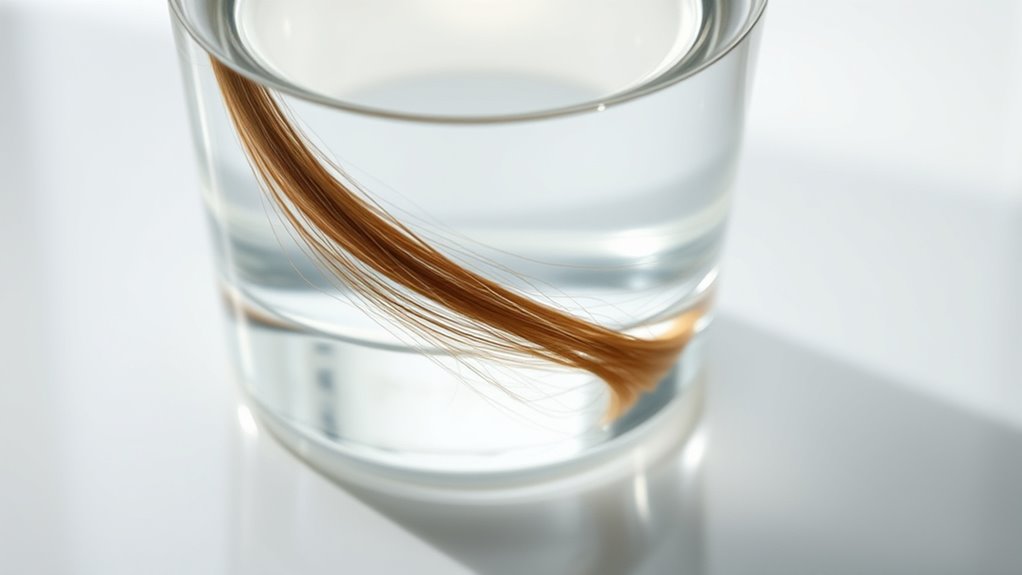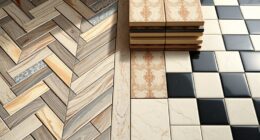To test your hair porosity, try the water test by placing a clean strand in a glass of room temperature water—if it sinks quickly, your hair is high porosity; if it floats or sinks slowly, it’s low or medium porosity. You can also run your fingers over a strand—rough or gappy texture suggests high porosity, while smooth indicates low. Knowing your porosity helps you choose suitable products and treatments—keep exploring to understand what your hair needs most.
Key Takeaways
- Test hair porosity using the water test: float, sink, or suspend to identify low, medium, or high porosity.
- Use the slide test by feeling the hair surface: smooth indicates low porosity; rough suggests high porosity.
- Knowing your hair’s porosity helps select appropriate products, like lightweight or sealing treatments.
- High porosity hair absorbs moisture quickly but loses it fast, requiring specific hydration and sealing routines.
- Medium porosity offers balanced moisture absorption and retention, ideal for most hair types.

Have you ever wondered why some hair absorbs moisture quickly while others resist it? The answer often lies in your hair’s porosity, which determines how well your strands can take in and retain moisture. Understanding porosity types is essential because it influences your hair care routine, the products you choose, and how you should treat your hair to keep it healthy. The good news is, testing methods are straightforward and can help you identify your porosity level, so you can tailor your hair care to your specific needs.
Understanding your hair’s porosity helps you choose the right products and care routine for healthy, moisturized hair.
There are three main porosity types: low, medium, and high. Low porosity hair has tightly bound cuticles that prevent moisture from entering easily. It tends to resist absorption but retains moisture once it’s in. Medium porosity hair has a balanced cuticle layer, allowing it to absorb and hold moisture efficiently. High porosity hair, on the other hand, has gaps or raised cuticles, making it absorb water quickly but also lose moisture just as fast. Recognizing which type you have can make a significant difference in choosing the right products—whether you need more hydrating treatments or sealing agents to lock in moisture.
To determine your porosity type, you can use simple testing methods. One common approach is the water test. Fill a glass with room temperature water, then take a strand of clean, dry hair and gently place it in the water. If the strand sinks quickly, you likely have high porosity hair. If it floats or takes a while to sink, your hair probably has low porosity. If it sinks slowly or stays suspended, you may have medium porosity. Another method involves the slide test, where you run your fingers over a clean strand of hair. If you feel a rough texture or notice gaps between cuticles, it’s a sign of high porosity. Conversely, very smooth, tightly packed cuticles suggest low porosity.
Getting familiar with your porosity type can save you time and frustration. It helps you avoid overloading your hair with products that don’t suit your needs or neglecting moisture altogether. For example, low porosity hair benefits from light, water-based products and heat treatments to open cuticles, while high porosity hair needs more sealing oils and protein treatments to fill gaps and prevent moisture loss. Knowing your testing methods and porosity types empowers you to create a tailored routine that enhances your hair’s health and appearance. Ultimately, understanding your hair’s porosity means you’re better equipped to care for it effectively, ensuring it stays shiny, healthy, and well-moisturized. Additionally, regular maintenance can help keep your hair in optimal condition based on your porosity.
Frequently Asked Questions
Can Hair Porosity Change Over Time?
Wondering if your hair porosity can change? Absolutely, it can! Your hair porosity, which affects how your hair absorbs and retains moisture, isn’t fixed. Factors like heat styling, chemical treatments, exposure to harsh elements, or even aging can cause hair porosity change over time. So, stay alert to these influences, and regularly test your hair’s porosity to keep your hair healthy and well-maintained.
How Does Porosity Affect Hair Color Treatment Results?
Your hair porosity markedly influences how hair dye absorption occurs and affects color longevity. High porosity hair tends to absorb dye quickly but may fade faster, while low porosity resists dye penetration, making color less vibrant initially but more long-lasting. By understanding your porosity level, you can choose the right products and techniques to optimize hair color results, ensuring your dye stays vibrant and lasts longer.
Is High Porosity Hair More Prone to Damage?
Think of high porosity hair as a fragile, open book vulnerable to damage. Yes, it’s more prone to hair damage because its cuticles are easily overwhelmed, letting moisture escape and harmful substances in. To protect your hair, choose gentle products that seal and nourish, preventing further damage. Proper product selection becomes your shield, helping you maintain strength and shine despite the vulnerabilities high porosity hair presents.
Can Porosity Testing Be Done at Home Accurately?
Yes, you can do DIY testing at home, but it might not be as accurate as a professional assessment. To test your hair porosity, you can perform simple methods like the float test or slide test. However, for precise results and tailored hair care advice, it’s best to visit a professional. They can provide a thorough assessment, ensuring you understand your hair’s porosity and how to care for it effectively.
What Are the Best Products for Different Porosity Levels?
For porosity hair, choose products tailored to your porosity level. If you have low porosity, opt for lightweight, water-based moisturizers and protein treatments to help absorption. For high porosity, look for heavy creams, oils, and sealants that lock in moisture. Medium porosity hair benefits from balanced products like leave-in conditioners and hydrating sprays. Always select product recommendations that match your porosity to keep your hair healthy and well-moisturized.
Conclusion
So now you know your hair’s porosity, you’re basically a science whiz. Imagine your strands as tiny sponges—some soak up water like a thirsty camel, others resist like a stubborn mule. Whether you’re dealing with high or low porosity, just remember, it’s all about finding the right products and routine. Because, hey, who knew your hair’s porosity was the secret to revealing that perfect, Instagram-ready glow—without needing a PhD in hair chemistry?









